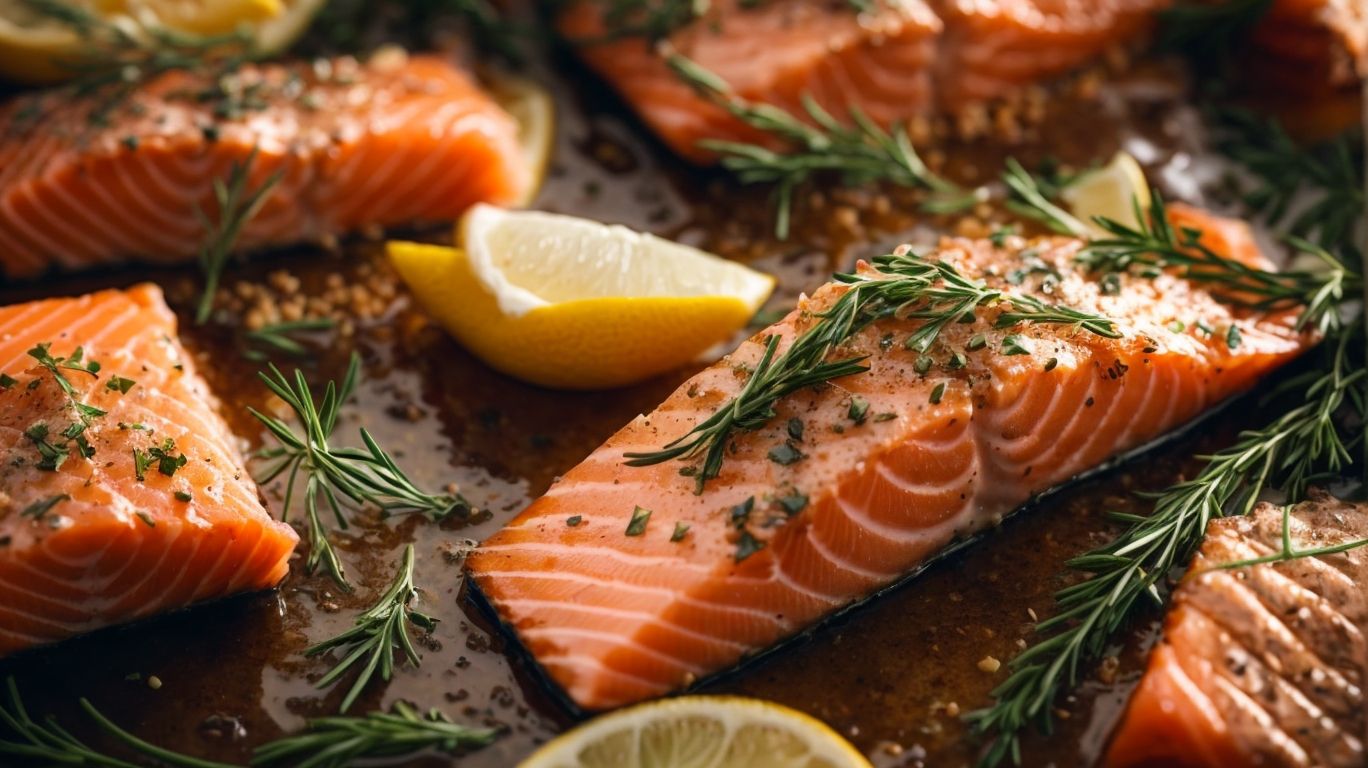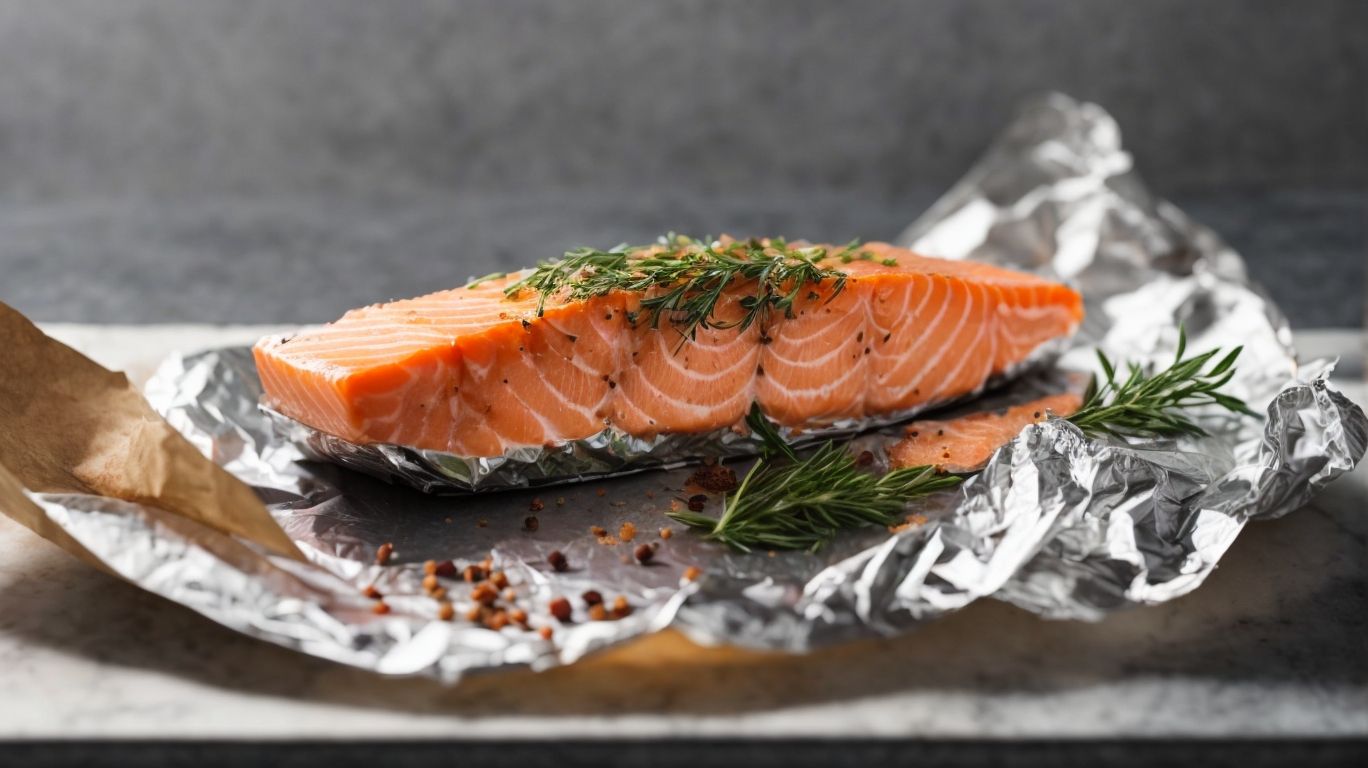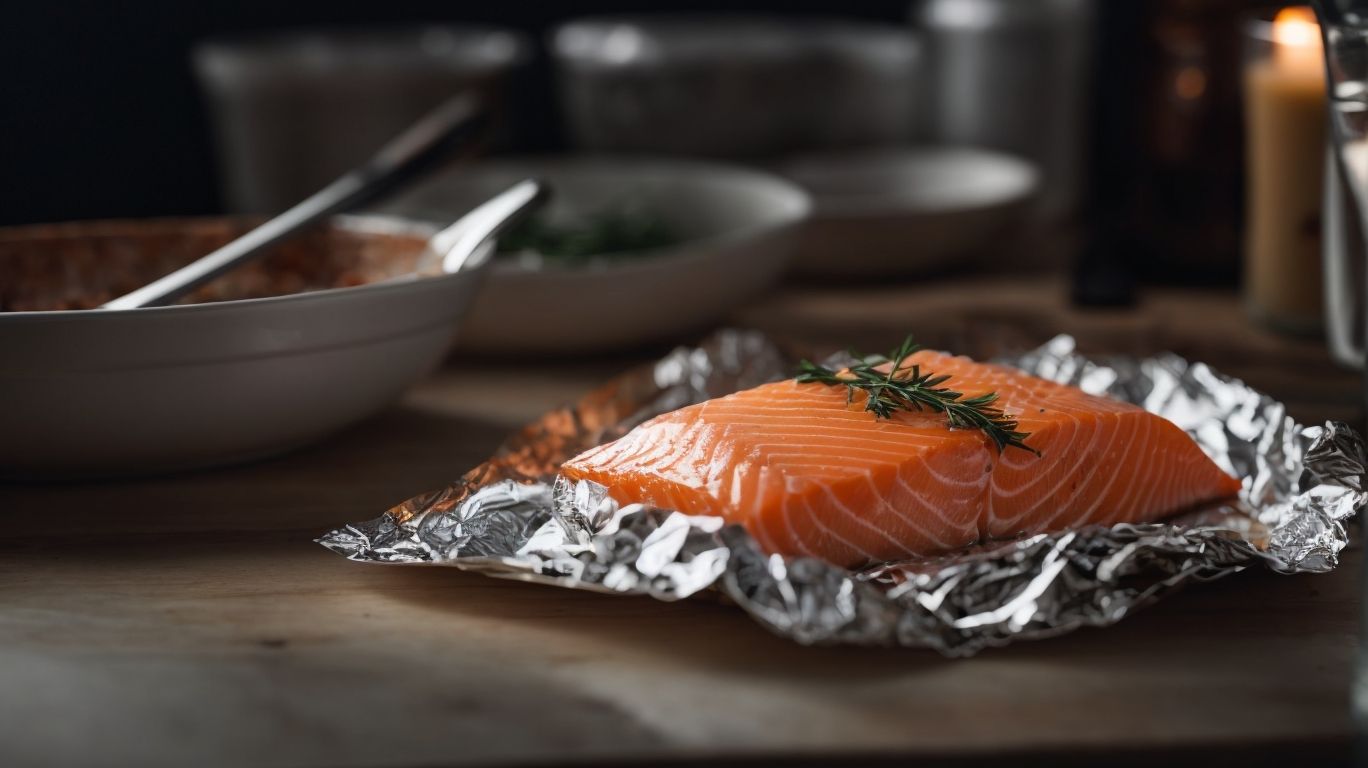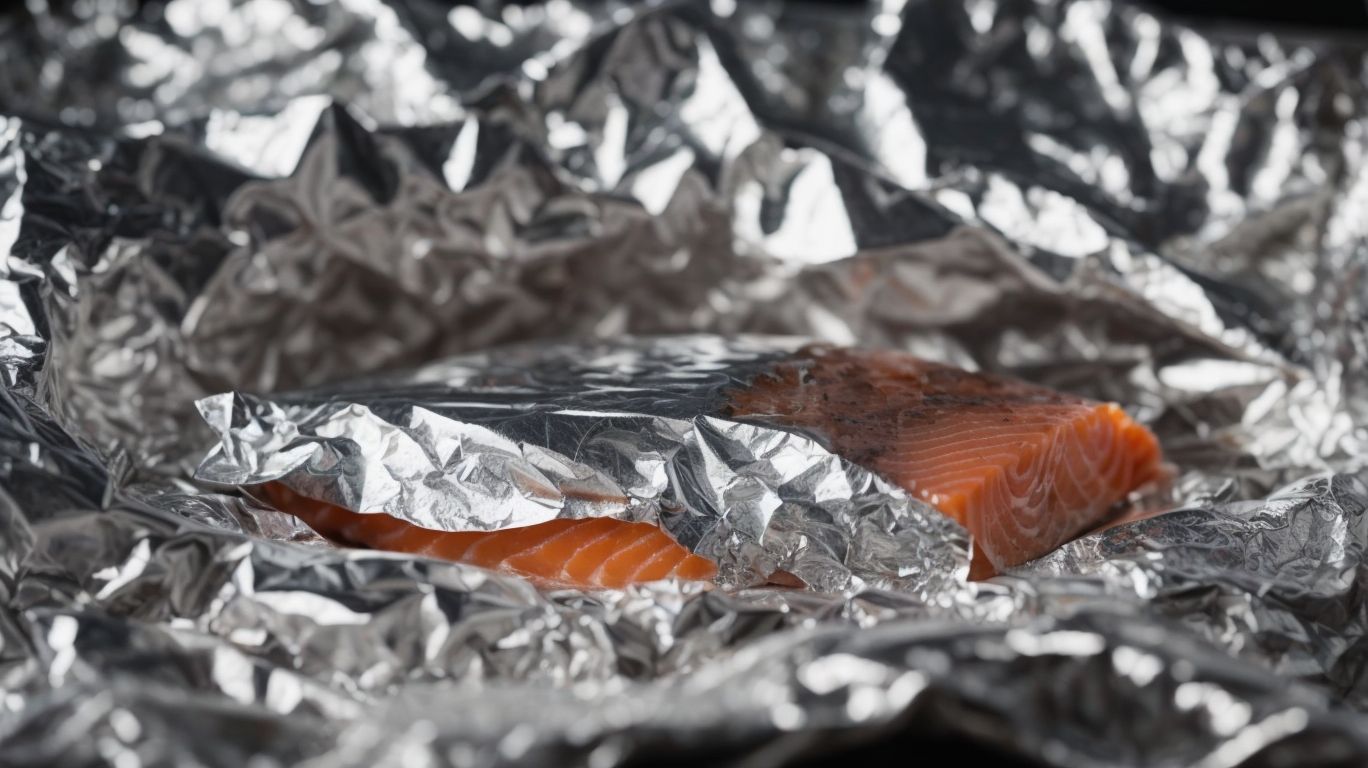How to Bake Salmon in Foil?
Welcome to Poormet.com, where we bring you culinary tips and recipes to make your cooking experience enjoyable.
Today, we’re diving into the art of baking salmon in foil.
From retaining moisture and flavor to easy clean-up and versatility, there are plenty of reasons why this cooking method is a game-changer.
In this article, we’ll guide you through the ingredients, step-by-step instructions, how to tell if the salmon is done, serving suggestions, and tips and tricks for perfectly baked salmon in foil.
Stay tuned for a delicious and informative read!
Key Takeaways:
Why Bake Salmon in Foil?
Baking salmon in foil is a popular cooking method that helps retain the moisture and flavor of the fish.
When you bake salmon in foil, it creates a sealed environment that locks in the natural juices of the fish, preventing them from evaporating during the cooking process. This means that your salmon remains moist and tender, without becoming dry or overcooked. The foil also acts as a barrier, protecting the delicate flesh of the salmon from direct heat, ensuring even cooking and resulting in a perfectly flaky texture.
Retains Moisture and Flavor
Baking salmon in foil ensures that the fish retains its moisture and flavor, resulting in a delicious and succulent dish.
Creating a flavorful and tender salmon dish can be achieved through the simple technique of cooking it in foil packets. The process of wrapping the seasoned salmon in foil forms a natural seal that helps to trap in the juices as it cooks. This method not only prevents the fish from drying out but also infuses it with the flavors of herbs, spices, and seasonings used in the preparation. The resulting salmon is not only moist and tender but also incredibly flavorful due to the way the foil locks in the flavor during the cooking process.
Easy Clean-up
Another advantage of baking salmon in foil is the easy clean-up process it offers after cooking.
When you cook salmon in foil packets, you significantly reduce the mess associated with traditional baking methods. The foil traps the juices and flavors, keeping the oven clean without any drips or spills to worry about.
Once your delicious salmon is cooked to perfection, all you need to do is throw away the foil, leaving you with almost no dishes to wash. This simple clean-up routine makes cooking salmon in foil perfect for busy weeknights or when you just want to enjoy a hassle-free meal.
Versatility
Baking salmon in foil offers great versatility in terms of preparation, making it a healthy and convenient meal option.
One of the main advantages of using foil to bake salmon is the ability to customize the dish to suit different tastes and dietary preferences. Whether you prefer a zesty lemon and herb seasoning or a spicy Cajun rub, cooking salmon in foil packets allows you to experiment with flavors effortlessly. The sealed environment created by the foil helps the fish retain moisture and infuses it with the added ingredients, resulting in a flavorful and juicy outcome. This method not only ensures a delicious meal but also preserves the nutritional benefits of salmon by minimizing nutrient loss during cooking.
Ingredients for Baked Salmon in Foil
To prepare baked salmon in foil, you will need fresh salmon, a recipe for seasoning, and a selection of herbs for added flavor.
When selecting the fresh salmon, ensure you choose high-quality fillets that are firm and have a vibrant color. For the seasoning, options like a simple lemon and herb mixture or a savory garlic butter blend work wonders in enhancing the natural taste of the salmon. Experiment with various herbs such as dill, parsley, or thyme to create a personalized flavor profile that complements the fish perfectly.
Step-by-Step Instructions
Follow these step-by-step instructions to bake salmon in foil to perfection, ensuring a moist and well-cooked dish.
To start, preheat your oven to 375°F.
While the oven is heating up, season your salmon fillets with a mix of your favorite herbs and spices – a combination of salt, pepper, garlic powder, and a hint of lemon zest works brilliantly.
Lay out a large piece of aluminum foil and place the seasoned salmon in the center. Wrap the foil around the salmon, ensuring it is completely sealed to keep the moisture locked in during cooking.
Preparing the Foil and Salmon
The first step in baking salmon in foil is to prepare the foil sheets and the salmon pieces for seasoning and cooking.
To begin, carefully lay out foil sheets on a flat surface, ensuring they are large enough to fold over and seal the salmon securely. Next, take the fresh salmon and pat it dry with paper towels. To make it easier to season and cook evenly, it’s important to remove the skin from the salmon. Using a sharp knife, gently slide the blade between the flesh and the skin to separate them. Once the skin is removed, cut the salmon into individual portions for serving.
Seasoning the Salmon
Once the salmon is prepared, season it with a delightful mix of lemon, garlic, olive oil, and herbs to enhance its flavor.
These ingredients not only add depth and richness to the salmon but also provide a burst of fresh and zesty flavors that complement the fish beautifully. The acidity of the lemon helps to cut through the richness of the salmon, while the garlic adds a savory undertone.
- Using olive oil helps to keep the salmon moist during cooking and infuses it with a subtle fruity flavor.
- The herbs, whether it’s dill, parsley, thyme, or a blend of your favorites, bring a fragrant and aromatic element to the dish.
For baked salmon in foil, you can customize the seasoning further by adding ingredients like paprika, cumin, or even a touch of honey for a sweet-savory twist. Experimenting with different combinations can elevate the dish and make it uniquely yours.
Adding Additional Flavors
To enrich the taste of the baked salmon, consider adding additional flavors like fresh rosemary for a delightful culinary experience.
Adding fresh rosemary to baked salmon not only enhances the overall flavor but also brings a fragrant and earthy element to the dish. The combination of salmon and rosemary creates a harmonious balance between the delicate fish and the robust herb.
- Other herbs and seasonings such as dill, thyme, or lemon zest can further elevate the taste profile of the salmon.
- Experimenting with different flavor combinations allows for a creative culinary exploration, offering a unique dining experience for yourself and your guests.
Remember that the key to successful flavor experimentation is to start with small amounts and gradually adjust to achieve the desired taste.
Folding and Sealing the Foil Packets
After seasoning the salmon, carefully fold and seal the foil packets to ensure the fish retains its moisture and texture during baking.
Proper folding is vital in trapping the heat and moisture effectively, leading to perfectly cooked salmon. To begin, lay out a piece of foil, ensuring it’s large enough to accommodate the salmon and allow space for folding. Place the seasoned salmon in the center of the foil sheet, then pull up the longer edges of the foil to meet at the top, creating a tent-like shape.
Next, fold the edges together by making small, tight folds along the open sides, starting from one end and working across. Be sure to press the folds firmly to create a secure seal. This method not only locks in moisture but also helps the salmon cook evenly.
Baking the Salmon
Place the sealed foil packets in the oven and bake the salmon at the recommended temperature until it reaches a perfect medium-rare doneness.
It is crucial to ensure that the salmon is not overcooked as it can quickly go from tender to dry. To achieve the ideal medium-rare texture, a temperature of around 120-125 degrees Fahrenheit is recommended, and a general rule of thumb is to bake the salmon for about 12-15 minutes per inch of thickness. Keep in mind that the cooking time may vary depending on the size and thickness of the salmon fillet, so periodic checks are essential to prevent overcooking. Remember, precision in monitoring both time and temperature is key to a perfectly baked salmon.
How to Tell if the Salmon is Done?

Credits: Poormet.Com – Brian Hernandez
Use a meat thermometer to check if the salmon is cooked to the desired level of flakiness, ensuring a perfectly prepared dish.
Begin by preheating your oven and placing the seasoned salmon on a baking sheet. Insert the meat thermometer into the thickest part of the fillet, ensuring it doesn’t touch the bone if present. As the salmon bakes, monitor the temperature closely.
The ideal internal temperature for cooked salmon should read 145°F (63°C) for optimal doneness. Along with the temperature reading, visually inspect the texture of the fish. Fully cooked salmon will easily flake when gently prodded with a fork, revealing a light pink hue throughout.
Serving Suggestions

Credits: Poormet.Com – Andrew Campbell
Pair your baked salmon with a variety of side dishes and salads to create a balanced and healthy meal for any occasion.
When serving baked salmon, consider adding some quinoa salad for a nutrient-packed side. The combination of the tender salmon and fluffy quinoa with fresh vegetables can provide a satisfying mix of flavors and textures.
Another excellent choice is a spinach and strawberry salad, which offers a delightful contrast of sweetness and crunch.
For a heartier option, roasted sweet potatoes make a delicious side that complements the richness of the salmon while adding a dose of fiber and vitamins.
Side Dishes
Complement your baked salmon with a selection of side dishes that add diverse textures and tastes to your meal.
Pair your succulent salmon with contrasting side dishes that elevate the dining experience.
- Consider incorporating roasted vegetables like asparagus or Brussels sprouts for a crispy texture and earthy flavor that complements the richness of the fish.
- A citrusy quinoa salad with a pop of freshness can be a refreshing addition, balancing the savory notes of the salmon.
- To enhance the meal further, opt for a creamy risotto or garlic mashed potatoes for a comforting accompaniment that contrasts the flakiness of the fish.
Sauces and Toppings
Elevate the flavor of your baked salmon with a range of sauces and toppings featuring herbs and spices for added taste dimensions.
Experimenting with new herbs and spices can take your salmon dish to a whole new level.
- For a zesty kick, try a lemon dill sauce made with fresh dill, lemon zest, and a dollop of Greek yogurt. This creamy sauce perfectly complements the light and flaky texture of the salmon, creating a harmonious blend of flavors.
- Another great option is a honey mustard glaze topped with a sprinkle of chopped chives. The sweet and tangy combination of honey and mustard adds an irresistible richness to the salmon, while the chives provide a fresh, aromatic finish.
Tips and Tricks for Perfectly Baked Salmon in Foil
Discover valuable tips and tricks to ensure your baked salmon in foil turns out perfectly every time, maximizing its flavor and nutritional benefits.
One key tip to enhancing the flavor of the salmon when baking it in foil is to create a delicious seasoning mix before wrapping it up. Consider using a blend of herbs, lemon zest, garlic, and a hint of spices to elevate the taste.
Another crucial aspect is to seal the foil packet properly to retain moisture and prevent the fish from drying out during cooking. This helps in preserving the natural juices and ensuring a tender and succulent outcome.
Regarding handling leftovers, remember to store the cooked salmon in an airtight container in the refrigerator promptly. Leftover salmon can be used in salads, sandwiches, or pasta dishes for a quick and nutritious meal option.
Conclusion

Credits: Poormet.Com – Brandon Ramirez
Baking salmon in foil is a delightful culinary experience that enhances the flavor of the fish, resulting in a delicious and satisfying dish.
One of the key benefits of using foil to bake salmon is its ability to lock in moisture, ensuring a juicy and tender final product. The process of enveloping the salmon in foil creates a mini-steam environment, allowing the flavors to infuse and intensify within the fish. The foil helps to prevent the fish from drying out during the cooking process, leading to a perfectly cooked, succulent salmon each time.
Frequently Asked Questions
How to Bake Salmon in Foil?
FAQs:
1. What is the best way to bake salmon in foil to ensure it stays moist and flavorful?
Wrapping the salmon in foil helps to trap in moisture and infuse flavor, resulting in a perfectly cooked fish.
What type of salmon should I use when baking in foil?
FAQs:
2. Can I use any type of salmon when baking in foil, or is there a specific type that works best?
You can use any type of salmon, such as Atlantic, Pacific, or Coho, when baking in foil. Just make sure to adjust the cooking time based on the thickness of the fillet.
Do I need to season the salmon before wrapping it in foil?
FAQs:
3. Should I season the salmon before baking in foil, or will the flavors be trapped inside?
It is important to season the salmon before wrapping it in foil, as the seasoning will infuse into the fish while baking. You can also add herbs, lemon slices, or other ingredients to enhance the flavor.
How long should I bake salmon in foil for?
FAQs:
4. What is the recommended cooking time for baking salmon in foil?
The cooking time will vary depending on the thickness of the salmon fillet. As a general rule, bake at 375°F for 15-20 minutes for 1-inch thick fillets, or 20-25 minutes for 1.5-inch thick fillets.
Is it necessary to preheat the oven before baking salmon in foil?
FAQs:
5. Can I skip preheating the oven when baking salmon in foil?
It is recommended to preheat the oven before baking salmon in foil to ensure even cooking. This also helps to prevent the fish from becoming overcooked.
Can I add vegetables to the foil packet with the salmon?
FAQs:
6. Is it possible to bake vegetables alongside the salmon in foil?
Yes, you can add vegetables such as asparagus, bell peppers, or zucchini to the foil packet with the salmon. Just make sure to cut them into small pieces and adjust the cooking time accordingly.

